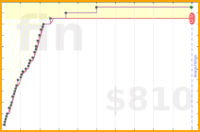Anonymous Sources at The New York Times
Last week the Public Editor of The New York Times, Clark Hoyt, criticized the paper’s common practice of using anonymous sources, often in flagrant violation of its own policy. Drawing on several recent examples, Hoyt demonstrates that casually granting anonymity facilitates personal attacks without repercussion, provides cover for those who make false or misleading statements, and generally damages the credibility of the paper. (This is a problem Glenn Greenwald has written about extensively.)
Despite his censure, citing a 2008 study by a group of journalism students at Columbia University, Hoyt states that the use of anonymous sources at The Times has decreased by about half since a strengthened policy was instituted in 2004. However, somewhat puzzlingly, a search of two news archives shows that the number of NYT articles in which sources spoke on “condition of anonymity” has steadily grown since 2000, both before and after the policy change.
The Columbia study was based on an examination of six issues of the paper before and six issues after Executive Editor Bill Keller wrote a February 2004 memo outlining the paper’s new, stricter policy on the use of anonymous sources. The authors defined:
“an anonymous source as one where information was attributed to someone whose identity is indiscernible to the lay reader. This includes attributions such as “sources said” or “experts said,” without further description of the speaker or the reasons for granting anonymity.”
By this measure, as Hoyt states, the study finds an approximately 50 percent reduction in the use of anonymous sources after the new policy was adopted.
As opposed to analyzing specific issues of the paper, I estimated the use of anonymous sources by: (1) searching the Google News Archives for NYT articles containing any of the phrases “condition of anonymity,” “requested anonymity,” or “anonymous source;” and (2) searching The Times’ Archive for articles containing the phrase “condition of anonymity.” (Note: The Times’ archive search does not appear to support the broad match used on Google News.) Estimates from both archives indicate a steady rise in the use of anonymous sources by The Times since 2000.
There are several possible explanations for the rather stark discrepancy between the Columbia study and my own analysis. I suspect, though, the difference is largely a result of the archive search identifying only instances of requested anonymity—in which sources explicitly ask to remain anonymous—whereas the Columbia study also includes instances of designated anonymity—in which reporters fail to name a source despite their willingness to be cited (e.g., abstract references to “expert” opinion). While requested anonymity may have risen (as indicated by the archive search), that increase may have been offset by a drop in designated anonymity. Importantly, designated anonymity is often not nearly as consequential and prone to abuse as is requested anonymity, and the two should not be counted together.
Given these seemingly contradictory findings, further investigation is warranted on the use of anonymous sources, and in particular, on the asserted effectiveness of the The Times’ policy to curb their use. At the very least, the conclusion that the 2004 policy halved the use of anonymous sources at The Times likely requires important caveats.
Illustration by Kelly Savage


